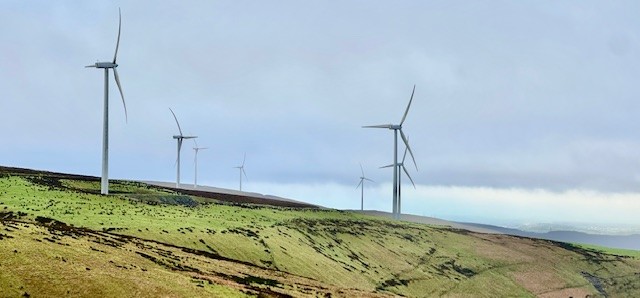I recently visited the proposed site of a new nuclear generator on my way to visit family. My links to nuclear and the Llynfi valley mean this project is more poignant than most to me.
A Brief History of Llynfi Power Station
The scenic Llynfi Valley and Maesteg in Wales is close to my heart as my family are from the area. I grew up with regular visits, spending every Christmas there. The Llynfi Power Station once symbolized the region’s industrial might and links to the coal of the region. Coal-fired, this station contributed to the local electricity supply for decades. Over time, due to shifts in the energy landscape and environmental considerations, Llynfi Power Station was decommissioned. Like many coal power stations across the UK, its legacy lives on and the local community was shaped by its presence and coal more broadly.
The Llynfi Valley: An Industrial Heritage with a Vision for the Future
- Rich Industrial Past: The Llynfi Valley boasts a heritage steeped in coal mining and heavy industry, serving as an economic lifeline for generations. You can read more about the heritage of coal and my family’s links to it in my blog from a few years back. Coal – EnergyStory
- Community and Culture: Residents of the valley have a strong sense of community, forged by years of shared work in local mines and factories.
- Transition to Green Economy: As industries evolve, the valley seeks new opportunities in renewable energy, tourism, and sustainable development—reflecting Wales’ broader commitment to environmental stewardship. The hills are dotted with wind turbines and the link to energy remains strong.

Last Energy’s Ambitious Plans
Enter Last Energy, an emerging player in the small modular nuclear reactor space. With a vision of providing up to 4 units of 20MW of clean, reliable power, Last Energy focuses on modular nuclear reactors that can be built more quickly and cost-effectively compared to traditional large-scale plants.
Small Modular Reactor (SMR) Technology
- Compact Design: SMRs are designed for smaller, standardized units, typically under 300MW, though Last Energy’s concept is to build an even smaller, 20MW footprint.
- Lower Upfront Costs: Standardized manufacturing can reduce construction costs and timelines, while minimizing on-site work.
- Enhanced Safety Features: Modern SMRs feature passive safety systems, ensuring they operate with minimal risk.
- Flexible Deployment: The smaller size allows for deployment in sites with limited grid access or in industrial clusters seeking dedicated power sources.
Why Llynfi?
- Existing Infrastructure: Former power station sites often have grid connections, water supply, and logistical links that make them attractive for new energy projects.
- Local Community Engagement: Redeveloping this site could bring new jobs, skills, and investment to a region with an established energy heritage and rich industrial skillsets.
- Decarbonisation Goals: A nuclear reactor of this scale supports Wales’ and the UK’s broader push toward net-zero emissions.
Potential Benefits for the Region
- Job Creation: From construction through operation, local employment opportunities would likely arise, boosting the area’s economic prospects.
- Academic links: Several universities are within close proximity to the site and may benefit from this new technological deployment.
- Clean Energy Generation: A 20MW nuclear reactor could supply constant, low-carbon power for nearby homes and businesses.
- Revitalizing Industrial Sites: Re-purposing brownfield sites aligns with sustainable development strategies and maximizes existing infrastructure.
The Road Ahead
The idea of a 20MW small modular nuclear reactor on the former Llynfi Power Station site is still in its conceptual stages. As with any nuclear proposal, comprehensive feasibility studies, community consultations, and regulatory reviews would precede any formal development. Environmental assessments and safety measures remain paramount to ensure the project aligns with local priorities and national guidelines.
In recent news in December 2024, the US Export Bank announced it’s willingness to support the project with debt finance in a boost to the project’s chances. US funding secured for Welsh microreactor project – Nuclear Engineering International
Nevertheless, Last Energy’s plans exemplify a broader shift in the UK’s energy strategy—one that embraces innovation, low-carbon solutions, and community-inclusive development. Whether it’s repowering an old coal site or pioneering new technology, projects like these demonstrate the potential for a clean, secure, and forward-looking energy future in regions with strong industrial legacies.

